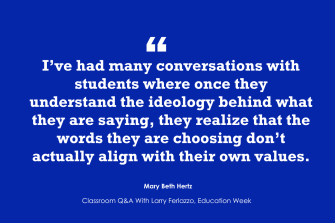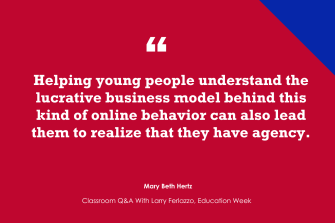The presence of Andrew Tate and the ‘Manosphere’ is felt in many classrooms today. Many teachers report that young male students have been influenced by Tate’s misogyny/sexism and have been exhibiting both toward female classmates and even teachers.
This two-part series will offer teacher perspectives on how to respond to the influencer and that concept.
‘Listen Carefully’ to What Students Are Saying
Mary Beth Hertz has taught young people in Philadelphia since 2003. She is the author of Digital and Media Literacy in the Classroom: Practice Classroom Applications and is the executive director of Walkabout Education, an organization dedicated to building experiential learning schools:
One of my favorite parts of the year in my 9th grade Intro to Tech class is our media literacy unit. Throughout the unit, students learn the difference between misinformation and disinformation and explore examples of the impact and widespread occurrence of this kind of information online. They also learn how to form search terms and analyze information they have found online. (We use the CRAAP test for this.)
Their main avenue for practicing their “crap detection” skills is a “research challenge” for which they create search terms, find sources, evaluate sources, take notes on the sources, and then write a paragraph that makes an argument based on their research. I assign them the topic Social Media and Teen Mental Health. This research is then turned into a conversational podcast as they pair up and combine their research to share their findings and conclusions with an audience.
As I was reading through their work recently, I noticed they had discovered a number of articles that discuss the impact that social media has on teen girls’ self-image. I asked them about it in class, and we discussed how unrealistic beauty standards can negatively impact teen girls. The conversation was centered on traditional gender norms since most of the research they found followed those lines.
I asked if anyone had found research about the impact that social media might have on boys’ self-image. No one raised their hand. I posed the question to them directly to see what they thought, and a couple of boys brought up health influencers and body builders and how that could also impact boys’ sense of self-image.
We then discussed what kind of content girls might see and what boys might see. These followed the expected “girls see makeup and fashion” and boys see “sports, video games, and fitness.” I asked if they had ever seen or heard of male influencers who talk about violence or in negative ways about women. Immediately to my right, I heard a boy whisper, “Andrew Tate.” I asked him to say it again louder and then asked the class if they had ever heard of him. A few hands went up, including that of one of the girls.
I had one of the boys explain what kind of things were shared by Tate and others like him. He described conversation around mistreating women and talking negatively about them. I then asked how that could affect boys who are watching the content. Students agreed it could impact how they view women.
Earlier in the year, students learn about how social media platforms work—how their profit depends on people spending more time on the platform and how the algorithms feed you content based on the content you already have been watching. I asked them what might happen if someone stumbled upon content created by Andrew Tate or a similar influencer. They explained that I might see more of that content “fed” to me by the platform, and it could influence how I think.
This was only a 10-minute conversation in my classroom, but it shone a light on the fact that the research on social media’s impact on young people has holes when it comes to the “manosphere” and its influence on young men as well as the impact it can have on young women.
While none of my students shared that they had experienced someone parroting this behavior, and the boys who spoke up and knew who Tate was didn’t seem to subscribe to his ideology, it is clear that young people are exposed to this content online no matter their gender.
As a parent of a soon-to-be tween boy, and as an educator who observes gender dynamics in my classroom, it is imperative for me to listen carefully to the words my students and my own son use and to recognize phrases or words that might come from these kinds of manosphere influencers so I can interrupt any situations where these ideologies might be present. Interrupting means asking questions and trying to understand whether young people subscribe to the ideology or are parroting what they hear.

For example, simple ask, “What do you mean by that?” or even, “Did you know that means/suggests …?” With my own son, I have asked, “I’ve never heard you use that phrase/word before. Where did you hear it? What does it mean?” I’ve had many conversations with students where once they understand the ideology behind what they are saying, they realize that the words they are choosing don’t actually align with their own values. If it is clear that the ideologies are actually what young people are subscribing to, the interrupting needs to be more direct. Letting them know that our classrooms, our homes, and our communities are places where we respect and care for each other and that kind of language or expression is not aligned with those values is a place to start.
Breaking down the reasons why influencers share the content they do (this is our “P” or Purpose in CRAAP detection”) and peeling back the curtain on the business models behind the content young people consume can also help them better understand how the technologies they use and the influencers using them profit off of their attention.
Helping young people understand the lucrative business model behind this kind of online behavior can also lead them to realize that they have agency in how they engage with content they consume. Ultimately, though, understanding why a young person is subscribing to or parroting an influencer like Tate or others is the most important first step. In order to do that, we must approach these conversations with curiosity and questions and honor what young people share with us.

Thanks to Mary Beth for sharing her thoughts.
Today’s post answered this question:
How is Andrew Tate influencing young male students, and what can teachers and schools do to respond to it?
Consider contributing a question to be answered in a future post. You can send one to me at lferlazzo@epe.org. When you send it in, let me know if I can use your real name if it’s selected or if you’d prefer remaining anonymous and have a pseudonym in mind.
You can also contact me on Twitter at @Larryferlazzo or on Bluesky at @larryferlazzo.bsky.social .
Just a reminder; you can subscribe and receive updates from this blog via email. And if you missed any of the highlights from the first 13 years of this blog, you can see a categorized list here.





